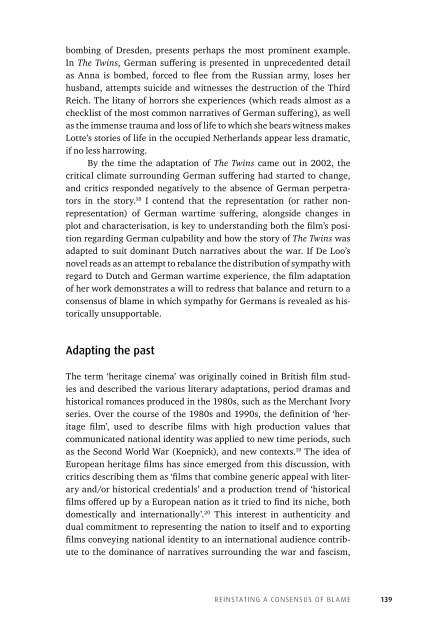Discord Consensus
7aze300jFJo
7aze300jFJo
Create successful ePaper yourself
Turn your PDF publications into a flip-book with our unique Google optimized e-Paper software.
ombing of Dresden, presents perhaps the most prominent example.<br />
In The Twins, German suffering is presented in unprecedented detail<br />
as Anna is bombed, forced to flee from the Russian army, loses her<br />
husband, attempts suicide and witnesses the destruction of the Third<br />
Reich. The litany of horrors she experiences (which reads almost as a<br />
checklist of the most common narratives of German suffering), as well<br />
as the immense trauma and loss of life to which she bears witness makes<br />
Lotte’s stories of life in the occupied Netherlands appear less dramatic,<br />
if no less harrowing.<br />
By the time the adaptation of The Twins came out in 2002, the<br />
critical climate surrounding German suffering had started to change,<br />
and critics responded negatively to the absence of German perpetrators<br />
in the story. 18 I contend that the representation (or rather non-<br />
representation) of German wartime suffering, alongside changes in<br />
plot and characterisation, is key to understanding both the film’s position<br />
regarding German culpability and how the story of The Twins was<br />
adapted to suit dominant Dutch narratives about the war. If De Loo’s<br />
novel reads as an attempt to rebalance the distribution of sympathy with<br />
regard to Dutch and German wartime experience, the film adaptation<br />
of her work demonstrates a will to redress that balance and return to a<br />
consensus of blame in which sympathy for Germans is revealed as historically<br />
unsupportable.<br />
Adapting the past<br />
The term ‘heritage cinema’ was originally coined in British film studies<br />
and described the various literary adaptations, period dramas and<br />
historical romances produced in the 1980s, such as the Merchant Ivory<br />
series. Over the course of the 1980s and 1990s, the definition of ‘heritage<br />
film’, used to describe films with high production values that<br />
communicated national identity was applied to new time periods, such<br />
as the Second World War (Koepnick), and new contexts. 19 The idea of<br />
European heritage films has since emerged from this discussion, with<br />
critics describing them as ‘films that combine generic appeal with literary<br />
and/or historical credentials’ and a production trend of ‘historical<br />
films offered up by a European nation as it tried to find its niche, both<br />
domestically and internationally’. 20 This interest in authenticity and<br />
dual commitment to representing the nation to itself and to exporting<br />
films conveying national identity to an international audience contribute<br />
to the dominance of narratives surrounding the war and fascism,<br />
Reinstating a consensus of blame 139


